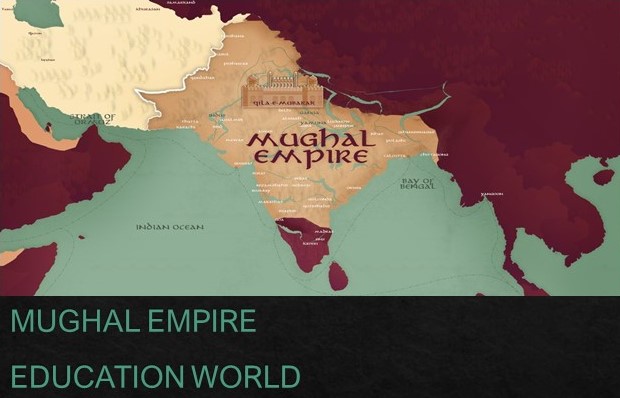DOWNLOAD OUR APP : EDUCATION WORLD

Turkic-Mongol origin that ruled most of northern India from the early 16th to the mid-18th century. The dynasty was founded by a Chagatai Turkic prince named Babur The first Mughal emperor (1526- 1530).Political situation in north-west India was suitable for Babur to enter India.
BABUR 1526-1530
1526 defeated Ibrahim Lodi and his Afghan supporters at Panipat.
Established control over Agra and Delhi before his death.
1527 defeated Rana Sanga.
HUMAYUN 1530-1540, 1555-1556
Humayun divided his inheritance according to the will of his father. His brothers were each given a province. The ambitions of his brother Mirza Kamran weakened
Humayun’s cause against Afghan competitors.
Sher Khan defeated Humayun at Chausa (1539) and Kananj (1540). forcing him to flee to Iran.
In Iran Humayun received help from the Safavid Shah. He recaptured Delhi in 1555 but died the next year after an accident in this building.
AKBAR 1556-1605
Akbar was 13 years old when he became emperar. His reign can be divided into three periods.
(1) 1556-1570-Akbar became independent of the regent Bairam Khan and other members of his domestic staff. Military campaigns were launched against the Suris and other Afghans, against the neighbouring kingdoms of Malwa and Gondwana, and to suppress the revolt of his half-brother Mirza Hakim and the Uzbegs. In 1568 the Sisodiya capital of Chittor was seized and in 1569 Ranthambhor.
(2) 1570-1585 military campaigns in Gujarat were followed by campaigns in the east in Bihar. Bengal and Orissa. These campaigns were complicated by the 1579-1580 revolt in support of Mirza Hakim.
(3) 1585-1605 expansion of Akbar’s empire. Campaigns were launched in the north-west. Qandahar was seized from the Safavids, Kashmir was annexed, as also Kabul. after the death of Mirza Hakim. Campaigns in the Deccan started and Berar, Khandesh and parts of Ahmadnagar were annexed. In the last years of his reign Akbar was distracted by the rebellion of Prince Salim. the future Emperor Jahangir.
Jahangir 1605-1627
Military campaigns started by Akbar continued. The Sisodiya ruler of Mewar, Amar Singh, accepted Mughal service. Less successful campaigns against the Sikhs, the Ahoms and Ahmadnagar followed. Prince Khurram, the future Emperor Shah Jahan, rebelled in the last years of his reign.
Shah Jahan 1627-1658
Mughal campaigns continued in the Deccan under Shah Jahan. The Afghan noble Khan Jahan Lodi rebelled and was defeated. Campaigns were launched against Ahmadnagar the Bundelas were defeated and Orchha seized. In 1632. Ahmadnagar was finally annexed and the Bijapur forces sued for peace. In 1657-1658, there was conflict over succession amongst Shah Jahan’s sons. Aurangzeb was victorious and his three brothers, including Dara Shikoh were killed. Shah Jahan was imprisoned for the rest of his life in Aura.
Aurangzeb 1658-1707
(1) In the north-east, the Ahoms were defeated in 1663, but rebelled again in the 1680s, Campaigns in the north-west against the Yusulzai and the Sikhs were temporarily successful. Mughal intervention in the succession and internal politics of the Rathor Rajputs of Marwar led to their rebellion. Campaigns against the Maratha chieftain Shivaji were initially successful. But Aurangzeb insulted Shivaji who escaped from Agra and declared himself an independent king .
(2) After Akhar’s rebellion Aurangzeh sent armies against. the Deccan Sultanates. Bijapur was annexed in 1685 and Golconda in 1687. From 1698 Aurangzeb personally managed campaigns in the Deccan against the Marathas who started guerrilla warfare. Aurangzeb also had to face the rebellion in north India of the Sikhs, Jats and Satnamis, in the north-east of the Ahoms and in the Deccan of the Marathas. His death was followed by a succession conflict amongst his sons
Table of Contents
MUGHAL EMPIRE HISTORY MCQ’s
1. The Ibadat khanna was a meeting house built by which Emperor ?
A.Babur
B.Humayun
C.Akbar
D.Aurangzeb
answer: c
2.Who was the architect who designed “Taj Mahal?
A.Muhammad Hussain
B.Ustad-Ahmed-Lahauri
C.Shah Isa
D.Ismail
answer : b
3.First invasion of India by Sultan Mohammed Gazni was in
A.1004 AD
B.1001 AD
C.1000 AD
D.999 AD
answer :b
4.______ the ruler of Iran.
A. Timur
B. Balban
C.Akbar
D. Firuz Tughluq
answer: a
5.Humayun had to run away from India after he was defeated in the battle of
A.Panipat
B.Ghagra
C.Khanwa
D.Kannauj
answer: d
6. Babur defeated the Lodhi army in which battle?
A.Panipat
B.Kurukshetra
C. Jaipur
D.Udaipur
answer: a
7.Sher Shah defeated Humayun and captured Gaur in the battle of
A.Ghaghra is 1529 A.D.
B.Chausa in 1539 A.D.
C.Panipat in 1526 A.D.
D.Khanwa in 1527 A.D.
answer : b
8.When did Humayun re-captured the empire in India?
(a) 1320 BC
(b) 1600 AD
(c) 1555 AD
(d) 1324 AD
answer: c
9.Whom did Akbar defeat in the second battle of Panipat in 1556?
A.Genghis Khan
B.Nadir Shah
C.Hemu Vikramaditya
D.Bajirao I
answer : c
10.Who of the following was sent as an ambassador to the royal court of Jahangir by James I, the king of England?
A.John Hawkins
B.Willia Todd
C.Sir Thomas Roe
D.Sir Walter Raleigh
answer :c
